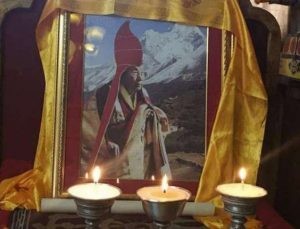
The Korean Seon (Zen) master Venerable Pomnyun Sunim (법륜스님) wears many hats: Buddhist monk, teacher, author, environmentalist, social activist, and podcaster, to name a few. As a widely respected Dharma teacher and a tireless socially engaged Buddhist activist in his native South Korea, Ven. Pomnyun Sunim has founded numerous Dharma-based organizations, initiatives, and projects that are active across the world. Among them, Jungto Society, a volunteer-based community founded on the Buddhist teachings and expressing equality, simple living, and sustainability, is dedicated to addressing modern social issues that lead to suffering, including environmental degradation, poverty, and conflict.
The following article is part of a series of essays shared by Jungto Society of notable highlights from Ven. Pomnyun Sunim’s writings, teachings, and regular live-streamed Dharma Q+A sessions, which are accessible across the globe.

Embedded in the desire for longevity is the yearning to not part with the people in our lives. As the old Korean proverb says: “A life in a heap of dung is still better than no life at all.” This implies that we are emotionally attached to life, despite the suffering we experience for various reasons.
People tell themselves that they only want to live until their children are married, until they have grandchildren, or just until the grandchildren go to college. Better yet, they say they want to live just long enough to see their grandchildren get married, all in an attempt to postpone the separation from their loved ones.
No matter how hard we try to avoid thinking about death, when we see people close to us die, we can’t help but confront the futility of life and the fear of death. There was a person who witnessed a family member, emaciated after years of illness, failing to swallow even a drop of water. The person wondered: “Does the spirit vanish when the body dies? If everything vanishes into nothingness, what is the point of holding onto life so dearly?” The gradual loss of weight when someone is at the very end of their life is a natural process, and it is not a bad thing. Like an oil lamp that quietly fades away, consuming every bit of your own energy as you pass away could be considered a good death. Additionally, if you can remain lucid until your last breath, that would be even better.
In the Heart Sutra, there is the phrase: “does neither appear nor disappear.” This does not mean that things continue to exist for eternity without changing. Rather it means that although we believe there are life and death, in truth, life and death are not two separate entities. When we go to the beach, we can see waves. The waves are formed and then they break once they reach the shore, and this process is repeated continuously. However, if you take a step back and view the sea as a whole, you will realize that it’s not that the waves are formed and then vanish, but rather the sea is just being turbulent. When you view life the way you view the sea as a whole, you will see that there is no life and death. When you observe individual waves, each wave is formed and then is broken just as life seems to appear and disappear on the surface. However, this is not the actuality; it is simply a matter of our perception.
Let’s say a four-year-old boy fills a bowl with ice cubes and then goes outside to play. When he returns a couple of hours later, he will see the bowl filled with water instead of ice. What do you think the boy would say?
“Mom, the ice cubes are gone, and there is water in the bowl.”
At this point, the mother, knowing what has happened, is able to explain to the boy that the ice has simply melted and turned into water. The ice cubes did not disappear into thin air, nor did the water suddenly appear from nowhere.
We are like this child. We perceive the world from the perspective of what we can see in front of us. We are happy when we see things appear and we despair when we see things disappear. However, when you are able to perceive the big picture, you will realize that things simply change. This is what the phrase “does neither appear nor disappear” means. In other words, things do not appear or disappear from this world; rather things only change their form.
The decomposition of a dead body and the daily regeneration of cells in a living body can be regarded as the same in that they are both expressions of change. In the same vein, the regeneration of cells in our bodies can be compared to the replacement of old pine needles by new ones, which makes evergreen trees appear green all the time. Also, the rapid process of decomposition of a dead body is analogous to the decay of fallen leaves, which makes trees look dead.
Despite the fact that change is the only constant phenomenon in this world, we believe that something is alive when we can see it and that something is dead when we can no longer see it. Furthermore, when something appears in front of our eyes, we think it is born. Thoughts also suddenly enter into our heads and just as suddenly they disappear. Even if we promise, “I will love you until death do us part,” love will diminish over time. Believing that love will last forever or hope that it won’t change is wishful thinking. Suffering is caused by your desire for things to stay the same, not by the change of heart.
If you fully accept that everything in this world changes, you will not feel so tormented when you see things change. Like the appearance and disappearance of waves, everything that comes into existence must come to an end. Once you fully grasp this truth, you won’t have fears or regrets. However, since you only perceive fragments of the big picture, you miss the things that you believe are gone and are afraid that things will disappear. After you realize that aging and death are simple changes, you will no longer be afraid.
See more
Pomnyun
Jungto Society
JTS Korea
JTS America
International Network of Engaged Buddhists
Related videos from BDG
Dharma Q+A with Ven. Pomnyun Sunim
Wisdom Notes from Ven. Pomnyun Sunim
Related features from BDG
What Is a Successful Life?
Turning Old Wounds into Life Assets
Facing the Challenges of COVID-19 Lockdown
The Hungry Should Eat: JTS Brings Buddhist Compassion and Relief to India
Engaged Buddhism: Seon Master Pomnyun Sunim Pledges 10,000 Tons of Food Aid for Children in North Korea
Engaging with Suffering, Realizing Freedom: An Interview with Ven. Pomnyun Sunim
Related news reports from BDG
Engaged Buddhism: Ven. Pomnyun Sunim Delivers Compassion to the Vulnerable in Korea
Engaged Buddhism: Jungto Society Delivers Compassion for the Vulnerable in Korea
Engaged Buddhism: JTS Korea Distributes Emergency Flood Relief in Cambodia
Engaged Buddhism: JTS Korea Donates COVID-19 Relief Supplies to Myanmar in Cooperation with INEB and KMF
Engaged Buddhism: Jungto Society Sharing the Gift of Compassion this Winter
UPDATE: Buddhist Relief from JTS Korea Transforming the Lives of Rohingya Refugees
Engaged Buddhism: JTS Korea Brings Warmth to Vulnerable Communities amid Winter Freeze














